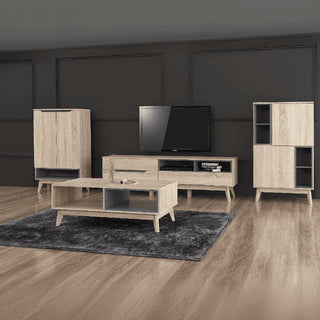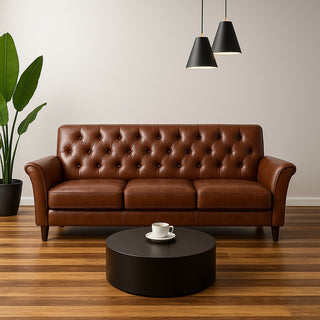A sideboard is more than just a stylish piece of furniture. It’s a functional storage solution that can transform the look and feel of your dining room. Whether you’re looking to store dinnerware, linens, or seasonal décor, choosing the right size sideboard is crucial to maintaining both form and function in your space.
But how do you determine what size sideboard is best for your dining room? In this comprehensive guide, we’ll explore key considerations for selecting the perfect sideboard size, tips on how to integrate it seamlessly with other furniture like your sofa, coffee table, and TV console, and why brands like Megafurniture offer exceptional options for every room in your home.
1. Understanding the Purpose of a Sideboard
Before diving into sizes, it’s essential to understand the primary purpose of a sideboard. A sideboard, also known as a buffet, is a long, low storage unit typically placed along a dining room wall. It is designed to provide extra storage while also serving as a surface for displaying décor, serving food, or even acting as a bar.
A well-chosen sideboard can also serve as a statement piece, complementing other furniture such as your bed frame, storage bed, and kitchen cabinets. But the key to achieving a cohesive look lies in selecting the right size.
2. Key Factors to Consider When Choosing a Sideboard Size
a. Room Size and Layout
The size of your dining room will largely dictate the size of the sideboard.
-
Small Dining Rooms: Opt for compact sideboards measuring between 30 to 40 inches in width. A smaller sideboard will provide storage without overwhelming the space.
-
Medium Dining Rooms: A standard-sized sideboard typically ranges from 40 to 60 inches wide. This size offers ample storage while maintaining balanced proportions.
-
Large Dining Rooms: If you have a spacious dining area, you can comfortably accommodate a sideboard 60 to 72 inches wide. This size can function as a buffet station or even house your TV console if the dining room is part of an open-plan living area.
b. Dining Table Size
A good rule of thumb is to choose a sideboard that is approximately two-thirds the length of your dining table. For example, if your dining table is 72 inches long, a sideboard measuring around 48 inches will provide visual balance.
c. Functionality and Storage Needs
Consider what you plan to store in the sideboard. Are you using it for dinnerware and cutlery, or will it house larger items like serving trays and tablecloths?
-
Storage Beds and Bedroom Sets: If you’re opting for a multifunctional sideboard that can also work in your bedroom, consider deeper sideboards (20 to 24 inches deep) to store bulkier items.
-
Kitchen Cabinets and Pantry Storage: In a dining room adjacent to the kitchen, a sideboard can serve as a mini pantry. Look for taller models with added shelving and drawers for maximum storage.
3. How High Should a Dining Room Sideboard Be?
The standard height for a dining room sideboard is between 30 to 36 inches. This height ensures that the surface is easily accessible for serving food while still being at a comfortable viewing height for décor or a TV console.
However, if you plan to use the sideboard as a buffet station, a slightly higher sideboard (around 38 to 42 inches) can make serving easier. This height is also suitable if the sideboard will double as a media console, aligning with your sofa and coffee table.
4. Sideboard Depth: Finding the Right Fit
The depth of a sideboard is equally important.
-
Shallow Sideboards (12 to 16 inches): Ideal for small dining rooms or narrow spaces. They provide surface storage without taking up too much floor space.
-
Standard Depth (16 to 20 inches): Offers a balanced profile, providing sufficient storage for dishes, glassware, and linens.
-
Deep Sideboards (20 to 24 inches): Best for larger rooms or open-plan layouts where you need ample storage for bulky items.
5. Coordinating with Other Furniture
To create a cohesive look, consider how your sideboard will relate to other key furniture pieces like your sofa, coffee table, and bed frame.
-
Living Room: If your dining room is part of an open-plan layout, choose a sideboard that complements your living room furniture. For instance, if your TV console is sleek and modern, opt for a sideboard with similar clean lines.
-
Bedroom: A sideboard can also double as a dresser or extra storage for your bedroom. Look for a design that matches the style of your bed frame or storage bed for a cohesive aesthetic.
-
Kitchen and Dining Area: Consider a sideboard with a similar finish to your kitchen cabinets to maintain a seamless flow between the two spaces.
6. Material and Style Considerations
The material and style of the sideboard can also impact its perceived size. For example:
-
Wooden Sideboards: These are versatile and can fit into both traditional and contemporary settings. Dark woods like walnut and mahogany can make a large sideboard feel more substantial, while lighter woods like oak or pine can create a more open, airy feel.
-
Glass and Metal Sideboards: These materials are ideal for smaller spaces as they reflect light and visually expand the room.
-
Mirrored Sideboards: A mirrored finish can make a large sideboard appear less bulky and more elegant, perfect for modern or glam-inspired interiors.
7. Megafurniture: The Go-To Source for Stylish Sideboards
When shopping for sideboards, Megafurniture is a trusted name offering a wide range of sizes, styles, and finishes. Whether you need a compact sideboard for a small dining room or a grand, statement piece for a spacious area, Megafurniture has options to suit every style and budget.
Our sideboards are designed to coordinate with other essential furniture pieces like bed frames, mattresses, storage beds, kitchen cabinets, and more. With options ranging from sleek, contemporary designs to rustic, farmhouse-inspired pieces, you’re sure to find the perfect sideboard to complete your dining room.
Conclusion: Choosing the Best Sideboard Size for Your Dining Room
Selecting the right sideboard size for your dining room is all about striking a balance between functionality and style. Consider the size of your dining table, the layout of your space, and the overall purpose of the sideboard. Opt for a size that not only fits comfortably in the room but also complements other furniture pieces like your sofa, coffee table, and bed frame.
At Megafurniture, we offer an extensive range of sideboards in various sizes and styles, making it easier than ever to find the perfect match for your dining room.
Ready to elevate your dining room with a stunning new sideboard? Explore the latest collection at Megafurniture today and discover the perfect blend of style, storage, and sophistication.







